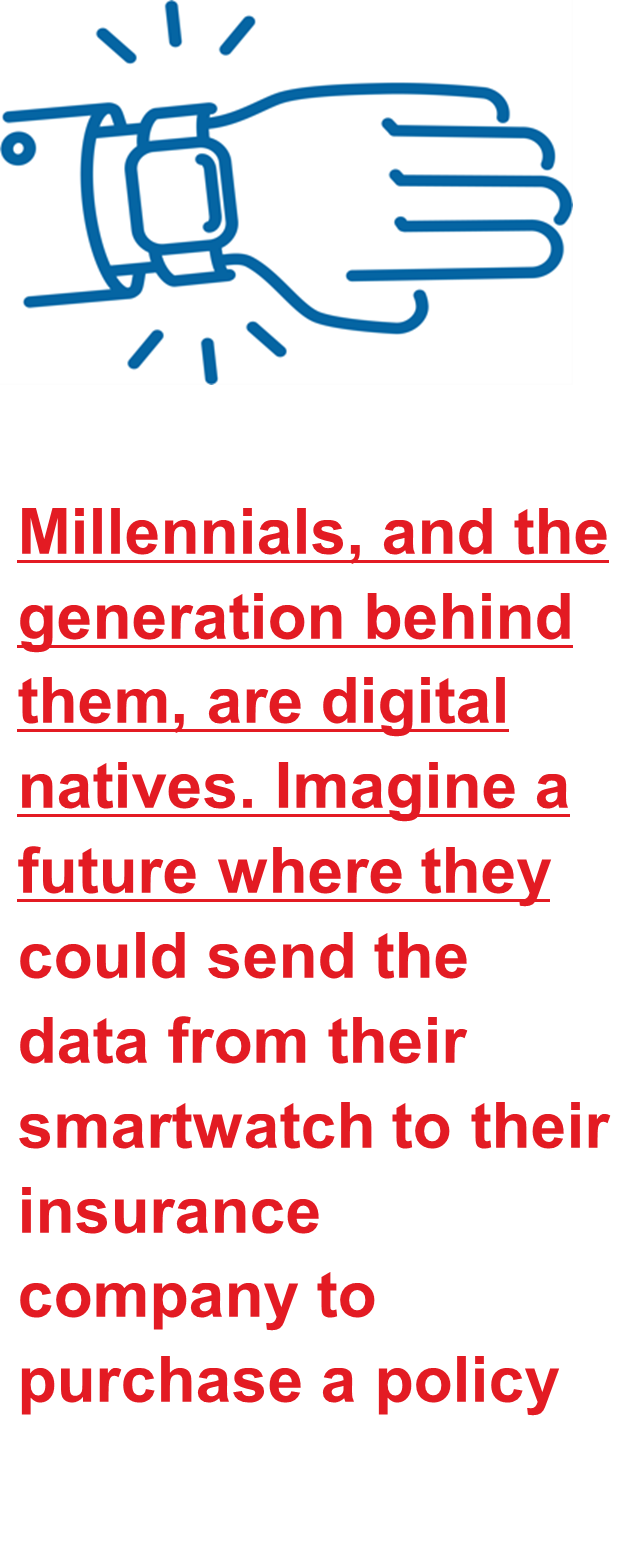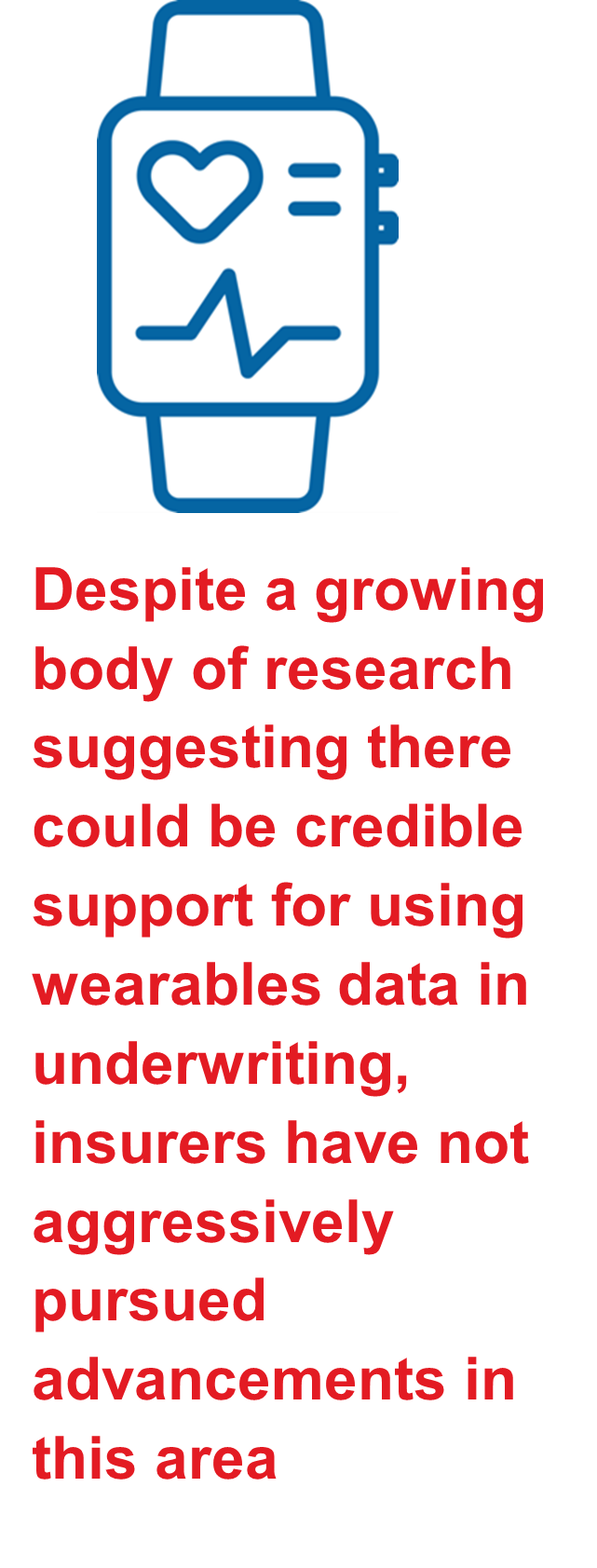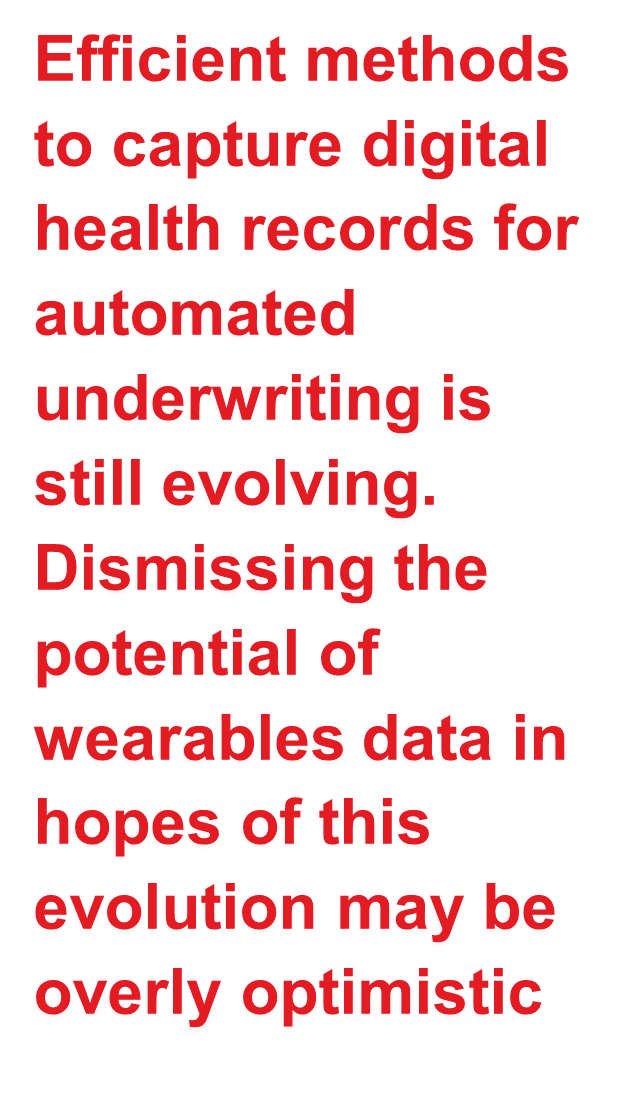Wearables Data – Beyond Customer Engagement
The path to disrupting the market with a simpler, more frictionless purchase journey
by Tonya Blackmore, Head Of AURA & Global Digital Underwriting, RGA
1. The Wearables Opportunity
The use of health-based trackers and fitness wearables has been steadily growing with an increase in consumer adoption during the pandemic as people turned to digital devices to manage their health and wellness. A recent study showed that 30% of adults in the U.S. use health-based wearables, mainly in the form of smartwatches, with nearly 50% using them every day[1].
The growing use of wearable devices has unlocked a new opportunity for insurers to engage with their customer base through wellness programs. These programs allow them to connect with and reward policyholders for healthy behaviors that are tracked and shared through their device. Also referred to as shared-value insurance, this type of engagement can benefit insurers in a multitude of ways. They can support a company’s ESG strategy by promoting healthier lifestyles that positively impact society, or act as a hedge against insurance risk by incentivizing healthy behaviors in their customers. Wearables can also provide rich pools of data useful in identifying high value customers for cross-sell and upsell opportunities.
Most interest related to wellness programs linked to wearables is currently focused on customer engagement. As wearable devices have matured, they are capturing a wider range and improved quality of health and fitness data that could have broader applications for insurers beyond customer engagement.
Underwriting is an obvious example. Early versions of smartwatch wearables were quite basic, mainly capturing step activity. If you scan the market now, the top products have more advanced analytics that can provide key insights about a person’s health. Although features vary by device, a typical smartwatch today captures the following information:
- Heart Rate, resting heart rate, and heart rate variability
- VO2Max measuring cardiovascular fitness and aerobic endurance
- Respiration rate tracking breaths per minute
- Blood oxygen saturation (Sp02)
- Fitness activities including type, intensity, and duration
- Fitness age derived through multiple metrics
- Electrocardiogram (ECG) on demand
- Sleep quality
- Stress level or body battery
Despite this data being available, the insurance industry has yet to apply it for underwriting purposes. The focus of this report is to assess the potential for using wearables data for underwriting and to identify the key barriers to progress that insurers need to address if they want to embrace this opportunity.
Evaluating a new source of health data and incorporating it into an underwriting program is a material investment requiring extensive analysis. More than likely, it would include clinical research, understanding medical advances, evaluating the credibility and reliability of third-party studies, obtaining expert input from clinicians, actuaries, and underwriters, and assessing external factors such as customer behaviors, product design and regulatory constraints. Not only would the investment in wearables data for underwriting be a heavy lift, but the environment is also nascent, dynamic, and evolving, making it more challenging to navigate.
Why put in the effort? Based upon the growth projections of the wearables market, and the advancements in the capabilities and metrics collected, there is a significant opportunity for insurers to tap into this growing customer base and disrupt the market with a simpler and more frictionless purchasing journey.
1.1 Growth projections for the wearables market
According to Technavio, the growth of wearables is expected to accelerate at a CAGR of 18.79% from 2020 – 2025[2]. Currently, the highest users of wearables are people between the ages of 25-34. The growth of wearables is partially being stimulated by the rising demand for contactless payments, such as Apple Pay, offered through smartwatch devices.
Insurers in the U.S. have traditionally found it difficult to attract millennials, who are now just reaching 40[3]. Millennials, and the generation behind them, are digital natives. Imagine a future where they could send the data from their smartwatch to their insurance company to purchase a policy. For insurers, how to apply wearables data in the underwriting process is a complex challenge to solve, however, whomever gets there first can gain a significant first mover advantage into a sizeable growing market.

1.2 Using wearables data to “accelerate” accelerated underwriting
Insurance companies have been making strides in accelerated underwriting for years, finding replacements for traditional underwriting that are faster and less intrusive. This focus on acceleration is driven from higher customer expectations and the need to improve a company’s application to placement ratios. There is a clear correlation of higher policy placement rates when the underwriting process is easier and shorter in duration.
Automated underwriting engines accelerate the underwriting process in two ways: allowing insurers to increase throughput and reduce turnaround time, and by integrating point-of-sale data sources to increase instant decisioning.
Despite these advances, and excluding simplified issue and guaranteed issue products, straight through processing (STP) rates for fully underwritten products remain in the 30 – 60% range. This demonstrates that there is still room for innovation to increase STP rates and obtain higher placement ratios. Leveraging wearables data may be the next place to look.
2. Potential to use wearables data for underwriting
There are two ways to consider the use of wearables data for underwriting. One way is to use the information to enrich the underwriting process and gain new insights in addition to what is already being collected. This could be helpful in terms of refining pricing and risk classes to be more competitive. If you imagine the future of wearables data in the context of disrupting the purchasing experience, it needs to do more than enrich the data set, it needs to transform the process by replacing portions of the traditional process.
The chart below explores the potential for how wearables data could be used to replace traditional underwriting. The left side of the chart outlines the key categories of risk information gathered by underwriters today and the right side outlines the potential for using wearables data as a replacement in this category.
| Key Information gathered for underwriting today | Potential to use wearables data to replace traditional underwriting |
| Current health | High potential Wearables data can provide insights about a person’s current health status through their physical activity levels and the health-related statistics gathered through the device |
| Age, Gender | Low potential The age and gender in the data set could be used to validate that the data from the wearable belongs to the applicant. This is a weak control for validation because age and gender are self-reported, and a person can fraudulently manipulate these fields to make it look like their data |
| Medical history | Some potential Health related data gathered from wearables may be able to predict an underlying medical condition |
| Risky hobbies | Low potential Garmin has an add on module for skydiving. Currently, no other smartwatches track information related to risky hobbies such as scuba diving or flying |
| Family medical history | No potential |
| Use of drugs, alcohol, and tobacco | No potential |
| Risky occupation | No potential |
2.1 Insights related to high potential - current health
Wearables data could have the greatest applicability to underwriting by providing key insights about a person’s current health status and how this information is associated with their life expectancy. This link between wearables data and predicting life expectancy is supported by a growing body of research that has shown the following correlations:
- the link between physical activity and mortality[4]
- the relationship between resting heart rate and life expectancy[5]
- the relationship between sleep and all-cause mortality[6]
- the relationship between V02Max and all-cause mortality[7]
- the relationship between changes in heart rate and red blood cell count[8]
As demonstrated through this research, there is potential that wearables data such as physical activity, resting heart rate, sleep statistics, V02Max and changes in heart rate could offer valuable insights into the current health and mortality risk of the applicant. If an insurer could reliably use this data rather than asking questions on an application, requesting fluids or medical reports, it presents an opportunity to speed up the process and drive STP and placement ratios. In addition, the information could be more reliable by capturing it from a data source versus the current process where a lot of the information used for underwing is gathered through customer self-disclosures.
Take, for example, BMI. When applying for insurance, companies will ask the applicant to disclose their weight and height to derive BMI, which is used to predict mortality risk. Behavioural science studies have shown that questions related to weight, height, smoking, drug, and alcohol use tend to have higher levels of inaccurate disclosures. Therefore, removing questions that ask an applicant to disclose this information and replacing it with data sources could give a more precise picture of a person’s associated risk class.
Wearables data, such as a person’s physical activity, may be able to eliminate the need to request height and weight disclosures, that is used to determine BMI.
Although one study evaluating the relationship between physical activity and BMI found no conclusive inverse relationship between hours of exercise per week and
BMI[9], another study showed evidence that even for overweight and obese people, the benefits of physical activity on lowering cardiovascular risk could offset the risks of having a higher BMI[10]. More research is required in this area but looking for ways to reduce disclosures and replacing them with wearables data could lead to faster and more reliable information for underwriting.
There is both a general acceptance in the underwriting community and adequate science to support that regular physical activity has positive health benefits and reduces the risk of mortality linked conditions such as cardiovascular disease, cancer, diabetes, and hypertension. This provides more support for insurers to consider how physical activity could be used to disrupt the underwriting process.
3. What barriers are preventing progress?
Despite a growing body of research suggesting there could be credible support for using wearables data in underwriting, insurers have not aggressively pursued advancements in this area. In consulting with underwriters, it was found that there are several barriers preventing progress. These can be grouped into two broad categories:
- Appropriateness for risk assessment
- Operational, cost and compliance challenges

3.1 Appropriateness for risk assessment
3.1a Anti-selection
One challenge with wearables data is that there is no way to validate that the data received belongs to the applicant, increasing anti-selection risk. Currently, medical records, lab results, prescription history, credit, and motor vehicle records gathered for underwriting can all be tied back to an applicant. Wearables data does not have a unique marker to validate the identity of the data source. This could lead to increased risk of anti-selection, affecting long term profitability of the business.
Another risk related to anti-selection is the person’s ability to cheat the system. For some devices and versions of smartwatches, a person can sit on the couch and move their arm back and forth and their device will interpret the movement as physical activity, adding to their daily step count. These types of deliberate mis-readings can lead to inaccurate representation of a person’s health.
3.1b Hawthorne effect
With wearables, if an applicant knew in advance that their data was going to be used to determine insurability, there is a good chance that they would improve their behaviour leading up to their application process, knowing they are going to be evaluated. This is known as the Hawthorne effect and it is commonly observed in weight loss programs where people lose more weight during the program when they are required track and disclose their food intake, but frequently gain the weight back when they leave the program and are no longer being evaluated. Given that underwriting decisions are made at the time of application, to get an accurate reading on a person’s typical behaviors, companies would need to collect a reasonable period of data to diminish the Hawthorne effect.
3.1c Reliability of the data
Medical professionals and product manufacturers of wearable devices both agree that wellness data and clinical data are not equal. Some of the measurements captured from wearables, such as the ECG reading, are FDA approved but many of them are not. Wearables providers post disclosures on their websites informing consumers of the limitations of the data and clearly warn that not all data collected is suitable to be used for medical purposes.
There is also variability in the data measurements across devices, even within the same brands. Two Garmin users, for example, can go for the same bike ride at the same time and have different statistics results, such as the number of kilometers or miles travelled, mainly due to differences in GPS quality. This variability of the data was further validated by a study conducted by RGA Reinsurance Company, where an 8% difference in steps were measured by different devices[11].
3.1d Giving double credit
When wearables data is used in association with other information gathered for underwriting, a key concern for underwriters is whether they would be giving a double credit for the data. When an insurer gathers information such as prescription history, digital health records, digital lab records, and wearables data, the information is evaluated holistically to determine the applicant’s risk. Therefore, to apply the use of wearables, it must be determined if there is new information gained that deserves an additional credit in the risk assessment, or whether that credit has already been given through the other information gathered. This process of determining how much credit to give and when, increases the complexity of developing an underwriting philosophy and rules based on wearables data.
3.2 Operational, Cost and Compliance Challenges
3.2a Complexities of collecting, protecting, and maintaining the data
The output of wearables data will vary between devices both in terms of how the data is captured from the person to the device and how the data is then exported to a third party. The types of measurements captured and how they are derived and described will also vary. The lack of standards across wearable devices and the need for the insurer to understand the different formats and measurements and subsequently map them into a structured, common format that is fit for analysis is a large and complex undertaking.
Consider the case where physical activity was being used as a measure. Physical activity can be measured in steps, minutes, hours, kilometers, miles, frequency of activity per week, intensity etc. A measure for physical activity would need to be established and then mapped and normalized across all data sets to determine the level of physical activity overall.
In addition to the effort to consume, transform, normalize, and analyze the data, each time a provider of wearable devices launches a new product or a new version of an existing product, there would be an ensuing effort to evaluate the change and incorporate new changes. This ongoing effort of reacting to changes in the external environment, layered with the strict data protection controls that would be required based upon the sensitivity of the data, means that the initial investment and the ongoing cost of ownership of managing the data would be high.
3.2b Lack of cost/benefit for the investment
There is scepticism that the data collected through wearables will be robust or reliable enough to replace enough of the traditional process to make the investment worthwhile.

Evaluating the current health of an applicant on its own, without considering broader risk factors such as medical or family history, makes the vision of being able to fully underwrite an applicant only using the wearables data difficult to imagine. Take, for example, an avid runner. The wearables data could show the applicant’s frequency of running, C02Max, heart rate recovery, and SP02, which could provide a picture of the applicant’s overall cardiovascular fitness and general health. What cannot be detected, however, is whether that person had cancer 12 months ago or if they have diabetes or a chronic heart condition, such as cardiomyopathy, that would not be detected through exercise. Recent cancer, diabetes or cardiomyopathy are all conditions that would lead to a higher risk rating for insurance or a possible decline.
With more and more access to digital health records and other sources of alternative data for underwriting, there is a concern that wearables data may not be worth the investment, especially if digital health records, which are considered the gold standard for underwriting, become ubiquitous.
Currently, using digital health records in accelerated underwriting faces many of the same challenges as using wearables data in terms of being able to efficiently collect, structure, maintain and normalize the data for fast risk assessment, but on a much larger scale. There are five major providers of smartwatch devices in the market compared to thousands of health providers capturing digital health data in different systems and structures.
There is a lot of focus across the industry to find efficient methods to capture digital health records for automated decisioning but it’s uncertain when this will be sufficiently advanced and operationalized. Therefore, dismissing the potential of wearables data in hopes of this evolution may be overly optimistic.
3.2c Regulatory Risk
An efficient method for harnessing the power of wearables data is to build predictive models to drive the risk assessment. Whether an insurer builds their own predictive models or procures them from a third-party provider, they have a regulatory obligation to understand the models that they use, and to ensure that they are not biased and are applying decisions fairly across their applicants.
This requires an added layer of analysis, governance, and audit controls to be in place to validate and document the models and to ensure that they are well understood and can be explained to an auditor or regulator. In addition, change management procedures need to be in place to confirm that updates are thoroughly documented, tested, and validated. The dynamic nature of managing wearables data increases regulatory risk and associated overhead for the organization.
4 Where do we go from here?
With any emerging opportunity, there is a natural maturity curve and wearables can be best described as in their teenage years. There have been significant advancements in the breadth and depth of health and fitness metrics captured by devices, but not all information captured is FDA approved and credible for clinical use, and variability across devices adds complexity to the risk assessment process.
On top of this, one of the greatest barriers to advancement facing insurers is the cost and complexity of securing, normalizing, and analyzing the data while responding to a fast-moving and dynamic market. The pace of change will require regular recalibration of models and/or underwriting philosophy and rules as product manufacturers innovate for growth and insurers are forced to react.
Despite these challenges, the most compelling reason for insurers to push forward and make a strategic investment in the future of wearables for underwriting is best depicted by a famous quote from Wayne Gretzky:
“A good hockey player plays where the puck is. A great hockey player plays where the puck is going to be”
The puck, or in this case, the wearables, are continuing to grow at a rapid pace, with a projected CAGR of 18.79% to 2025. Further, the fastest growing adopters are between the ages of 15-34, the future buyers of insurance. This generation will expect companies to be digitally forward and offer customized products and services that can interact seamlessly with their devices. The under 40 age segments has been the most difficult for insurers to attract, hence the strategic importance of meeting them where they ‘technologically’ will be.
In addition to the market growth potential, the quality of the data from wearable devices continues to advance, with better and new measurements emerging. Therefore, looking forward there are broader opportunities to move beyond customer engagement and utilize the data for underwriting.
Based upon the growth projections of the wearables market, and the rich pools of health data that will be available, it’s not a matter of if someone will crack the code to unlock the value of this data, it’s a matter of when. Whomever gets there first could have a significant first mover’s advantage while others will need to invest heavily in a complex structure before they can catch up.
Given this, insurers should consider how to get started today in a risk appropriate and progressive manner that allows them to learn and experiment as the opportunities and data matures. This will position them to informatively scale up, scale down or pivot based upon the learnings, and it gets them active in the market iterating and testing while managing risk and cost.
To direct this effort, following is a Five Phase Guide to Adoption on how to get started now.

Five Phase Guide to Adoption
4.1a Phase 1: The power of partnerships
Large, complex, multi-functional projects bringing together technology, actuarial, data science, risk management, legal, compliance, and underwriting to launch a nascent initiative is a very high-risk undertaking. To help mitigate this, companies should consider partners who can bring specific areas of expertise to reduce market entry risk.
As the wearables market is growing, so is the ‘wearables data as a managed service’ market. These providers can be key enablers to begin the journey without the insurer having to build the infrastructure, data structures, controls, and processes and invest in the overhead themselves. This allows them to focus on their areas of expertise and it provides the flexibility to scale up or scale down as they progress through the stages analyzing the data, building models, and generating actionable insights to drive growth for the company.
4.1b Phase 2: Gathering, learning and insights
The current trend of insurers offering wellness-driven client engagement programs is a low-risk way to enter the gather and learn phase. This stage allows insurers to set up their data management infrastructure and processes, engage with clients and gain access to wearables data. It’s considered low risk because they aren’t binding risk based upon the data, they are simply gathering, learning, and forming insights. The wellness programs in the market today mainly offer reward points for healthy behaviors that can be redeemed for gift cards or other benefits that aren’t necessarily tied to the insurance policy. Offering reward-based programs gives the insurer the benefit of acquiring pools of data without having the increased risk of making long-term commitments prematurely. Launching a client engagement program where clients can provide wearables data in exchange for rewards is a low-risk entry strategy into the market, while improving customer engagement overall.
4.1c Phase 3: Lead generation
In this phase, once the insurer has gained information from observing the data and forming insights through internal analysis and reviewing external research, they can begin to drive new product growth opportunities. An example would be leveraging the data and insights for lead generation to identify high value leads from their customer base to cross-sell and up-sell new products. These products could be offered on a pre-approval basis and still contain and underwriting process, gathering traditional information before binding the risk. This is a valuable way to test the data insights against the underwriting decisions to measure decisioning alignment and refine and course correct as needed along the way.
4.1d Phase 4: Underwriting simplified products
As the process and understanding of the data matures, the next step would be to begin integrating wearables information into the underwriting process and making risk decisions with the data. In this phase, the focus would be on underwriting for simplified products with the potential to offer a more refined risk assessment with the addition of this data. Simplified risk products are priced according to the limited data collected and having an enriched data set with wearables insights could lead to more competitive pricing in the market.
4.1e Phase 5: Fully accelerated underwriting
The final phase in maturing this process is moving into fully accelerated underwriting by using the wearables data as a proxy for traditional underwriting, thus disrupting the customer purchasing experience. This is the most complex stage to enter because to shorten or accelerate the existing process, and gain a competitive advantage, it’s essential to determine what traditional evidence can be replaced by the wearables data. At this stage the assumption is that the insurers data management process has matured, some historical data and experience is available, and more research and studies have been conducted to back mortality and pricing assumptions.
This stage is also catalyst to launch continuous underwriting, which provides the opportunity for new product development and the ability to offer discounts to policyholders overtime as they demonstrate ongoing healthy behaviors.
As outlined in Figure 1 below, these five phases provide a practical building block approach that enables the insurer to reduce their time to market and to actively participate, experiment and learn while managing their level of investment and risk along the way.
Using wearables data for underwriting is the ultimate destination and these phases provides direction and discipline throughout the journey.
See Figure 1. Five Phase Guide to Adoption in downloadable paper
[1] NCBI, https://www.ncbi.nlm.nih.gov/pmc/articles/PMC7600024/
[2]https://www.prnewswire.com/news-releases/smartwatch-market-size-to-grow-by-usd-27-96-bn--technological-advances-in-semiconductor-industry-to-drive-growth--technavio-301529095.html
[3] https://lewisellis.com/industry-insights/article/40190048-do-millennials-still-go-without-life-insurance
[4]https://www.rgare.com/knowledge-center/media/articles/quantifying-lifestyle-behavior-holds-the-key-to-wider-adoption-of-insurance-linked-wellness-programs
[5]https://www.rgare.com/knowledge-center/media/articles/better-underwriting-decisions-are-just-a-heartbeat-away
[6]https://www.rgare.com/knowledge-center/media/research/wearable-technology-in-life-insurance
[7]https://www.rgare.com/knowledge-center/media/research/wearable-technology-in-life-insurance
[8] https://med.stanford.edu/news/all-news/2021/05/smartwatch-data-can-predict-blood-test-results.html#:~:text=The%20answer%20was%20a%20resounding,taken%20at%20a%20doctor's%20office.
[9]file:///C:/Users/s0045973/Downloads/Dialnet-ExerciseAndBodyMassIndex-5599496.pdf
[10]https://www.ncbi.nlm.nih.gov/pmc/articles/PMC5510687/
[11]https://www.rgare.com/knowledge-center/media/articles/wearable-wellness

